I thought it would be a good idea to do a recap of my blog’s year, but rather than talk about recipes I go through and highlight what I’ve learnt through my posts. Starting at the beginning of the year :
Stoping Ice-cream Becoming Too Hard
Recipes which contains a lot of egg yolks will stay softer, yolks contain proteins and emulsifiers that help keep ice crystals small and stop mixture from forming further ice crystal while stored. Adding high fat cream will also help, especially if heating up cream first as it “..improves body and smoothness by denaturing the whey proteins, minimize size of crystals” (Harold McGee).
Cooling the ice-cream as fast as possible creating small crystals gives you a better smoother texture, that’s why liquid nitrogen is excellent for this. When storing the ice-cream in freezer shallow containers are better than deep boxes, cooling it faster.
The biggest friend in keeping ice-cream or sorbet soft is inverted sugar, liquid glucose. Ice-cream hardens in the home freezer because domestic freezer temperatures are too cold for ideal ice-cream storage, but once brought out to room temperature for 10mins, having the liquid glucose, will still produce a soft ice-cream like this chocolate one. Liquid glucose is your guarantee card.
Inverted Sugar & Wonders Of It
I discovered this January how I had accidently made my own inverted sugar in the previous year without knowing, when boiling down syrup I poached pears in which contained a little lemon juice. Inverted sugar is sugar boiled down with some acid briefly until its molecules have been broken down to the extent they can’t re-form and crystalise.
Food and drinks manufacturers are the ones who make the biggest use out of inverted sugar, because it makes baked goods stay moist for longer, making shiny smooth icings and fondants, and prevents confectionery and frozen desserts from crystallising.
The ideal amount of liquid glucose to use in a recipe sits around 4-6%.
Caldo Verde is Not Made With Kale Cabbage
OK so this one isn’t technical but never the less it was important for me to figure out why people outside Portugal think kale cabbage is the correct cabbage for this soup.
I researched and found the confusion being in the dictionary when translating the Portuguese word ‘Couve’. Couve means cabbage that’s of the open leaf variety in Portuguese, as appose to cabbage that grows into a tight ball like savoy cabbage for example. In the dictionary from Portuguese to English, the entry for ‘couve’ is translated as ‘kale’. Whenever people want to find out what couve is, they think it means kale.
The correct cabbage for caldo verde is collard greens, rolled up very tightly and cut super thin, here the nearest cabbage I can get to collard are the so called ‘greens’ cabbage.
Coconut Milk
Huge difference in quality of coconut milk from watery thin to thick double cream thickness, it pays to shop around different brands. The reason I’m making a point of this is because when recipes call for a tin of coconut you may end up with a dryer or thinner sauce dependent on the variety you have.
Pavlova
When adding the cornflour to make pavlova add it last, once you’ve mixed in all the sugar, folding it in. Adding before that makes the meringue collapse quicker into a flatter shape by the time you’ve put it into the oven.
Parsley
Curley leaf parsley when mature is stronger than large flat leaf parsley, due to a larger content of myristicin (volatile organic compound, found in nutmeg). Though I have known the following for some time it’s useful to know when making family dinners, parsley contains the biggest concentration of vitamin C to any other food.
Broa – Corn & Rye Bread
When using a flour like rye which has one of the gluten protein’s missing, glutenin, (or to be more precise the small amount of glutenin it has it’s of such poor quality) and another flour like corn with no gluten, it’s best not to let it rise more than once, because the flours can’t cope with it, they can’t retain the gases well. Or if you have trouble with this one rise concept then reduce greatly the whole rise & rest time of the dough.
Dan’s Bap Recipe – Potato Flour
Making Dan’s bap recipe many times as a sandwich loaf, using some potato flour instead of the cornflour, made me discover how potato flour in a bread produces great toast. There’s something about potato and crispness on toasting, maillard reaction going on. Adding too much will produce horrible mouth-feel crumb, this is where a little goes a long way.
Experimenting with 5 Different Protein Flours
This experiment of trying out bread flour ranging from 11% protein – 15% protein was the beginning of my true understanding how flours can make all the difference in producing a loaf.
This simple crude test was about the absorption of water, high protein flours generally absorb more water. This test showed how the same recipe resulted in different open crumb depending on the flour used. This meant that concerning yourself only with the hydration of a recipe was pointless unless you knew the absorption quality of the flour.
This gave me my first insight into how low protein flours can produce great bread. It put me on the right track to all my subsequent learning about flours.
How to Make Choux Pastry
After making what seemed to be endless batches of choux pastry and failing at producing a crisp dry pastry following a Roux brother’s recipe, I discovered the best way to make them was to lower the temperature once in the oven. At the end of baking decrease temperature further, letting them dry out properly for a few minutes. If choux pastry is dried out properly in the oven it will not soften once out.
Also choux made with water gives a crispier result than one that has milk in it. This is also the case with other batters, milk is a great “softner” of baked goods.
Eggs Make a Different to Cake Colour
I tested Clarence Court eggs and organic eggs in a cake recipe and confirmed what I knew already from my Gran’s eggs back in Portugal; depending on the colour of your eggs from the feeds the chicken has had, they will produce a golden yellow cake. If I want to get the same golden cake as I do from my Gran’s eggs I have to buy eggs like the Clarence Court ones above. It matters what chickens eat, the same way it matters what cows feed on to produce good quality milk/butter.
Having said this be aware colour feed is allowed to be added to chicken feed to get the desired yellow/orangess in yolks. And as an egg farmer recently commented on the post, colour isn’t everything, certainly true when talking of nutritional value but it’s nice to occasionally produce a golden yellow sponge cake like my Granny can.
Paris Bakeries & Jean-Philippe de Tonnac
Spending a day visiting some good bakeries in Paris with the wonderful, kind, enthusiastic writer Jean-Philippe de Tonnac was certainly a highlight this year. We didn’t make it to as many bakeries as we would like, in part because we did that French thing of sitting in a cafe and talking. If you’re on facebook Jean-Philippe has a fb page on all things bread that’s worth signing up to called UniversalBread.
Light Scones & Gregoire Michaud
Throughout the year I make various references in my blog to a great baker & pastry chef, Gregoire Michaud, an all-round great human being. Someone who manages to find time for charitable work and still fit in answering questions on twitter to enthusiastic bakers. A lovely lovely person.
I’ve picked up some useful tips such as producing these incredibly light scones, and discovering how dough with baking powder can be left overnight. This went against my previous learning.
13 hour Sourdough Crumb
Through necessity when baking 16 loaves for an order for the first time, I discovered how different sourdough crumb can be when leaving on final prove 8-13hrs at a cool room temperature of 8-10C (46-50F). This results in an incredibly light crumb for a sourdough.
Even if this is not your preferred texture it’s still a useful skill to have at your disposal. I have a regular client that loves her sourdough like this.
You can see from the scoring on the loaves above, because they are proved to their limit you won’t get a dramatic ‘rip’ effect on the crust, since the rise in the oven will be considerably less.
Potato Bread
I’ve had quite a few potato bread disasters this year. Adding potato to your bread if not careful can be detrimental. It will result like the dough below with collapsed gluten structure, leaving your dough without strength to hold itself.
If you get it right however, it is one of the best ways to produce an incredibly light open crumb. Again as before with adding potato flour, this bread will also produce super crisp toast.
I’m not sure why yet from a biochemistry point of view, but yeast seems to adore potato, maybe because it’s full of the simple sugars in its starch structure. I have looked for good details on sugar structure in potato but haven’t succeeded.
Dan Lepard
This year has been a year of meeting incredibly talented people, Jean-Philippe, Gregoire and another multi-talented baker/photographer/writer, Dan Lepard. I enjoyed writing the post on Dan, tracking his baking career to the present with his new book Short & Sweet.
It wasn’t until meeting Dan, above, did things click into place, such as why he was so good at photography! Modest with some English reserve in him, it’s only the occasional note of his Australian accent that gives away his place of birth. A warm attentive person who goes about quietly helping wannabe bakers where he can, as well as charitable work he and partner David carry out.
If you follow my blog then you’ll know I pretty much learnt sourdough through Dan’s recipes, for that I’m internally grateful!
A tip form Dan when rolling out sourdough/hybrid baguettes using his folding method; on rolling them out do it in 2 stages with a rest in-between.
Over-Proving Dough
There are many ways to kill off a loaf and leaving it out in a hot summer’s night is a good way. There is only so much abuse yeast can take at the wrong temperature. Finding the limits is a great learning curve. Push dough to a limit and learn.
Understanding How a Sourdough Starter Works
Blog Post Here and Here
This post on Lactic Acid Bacteria was the most important learning curve for me this year. Understanding what’s going on in the starter and how to influence its outcome is essential in mastering your sourdough.
Baker Paul Merry
The meeting of great bakers and all round good guys continued this year with Paul Merry. Paul was the perfect mentor for me, an intelligent guy with an aptitude for the detail, the sort of person I could bounce ideas off. I thoroughly enjoyed my workshops with him. He introduced me to the 2 hour levain, something I now use all the time, the difference in handling ‘ripe’ and ‘unripe’ doughs and other useful nuggets of bread techniques.
Farmer, Miller & Baker, Roland Feuillas
I couldn’t ask for a better ending to meeting great bakers this year than finishing with Roland Feuillas, who’s passion, drive, enthusiasm for his beloved subject, flour is infectious. If you haven’t read my original post on Roland read it now and you’ll see why he stands out from your average baker.
Even if you don’t obsess about flour you can’t walk away from the beautiful surroundings of Cucugnan without being inspired by the scenery.
Low Protein Flours Make Great Bread
To finish off my baking learning curve this year, I was introduced to a stoneground flour, Amaretto milled by Anne & Andrew Parry in Wales. Beautiful flavour common wheat variety with an incredible late rise in the oven resulting in dramatic tears in the loaves. Amaretto is a great example of just how common wheat can be so different, interesting and rewarding to work with.
2011
I have learnt other things this year through this blog but this post is already too long.
At the beginning of 2011 I could never imagine I would end up where I have now. I never thought I would or could become a baker, but I have. In the process I have met some extraordinary people. I have also made some new dear friends through this blog and twitter. Who knows what 2012 will bring for me but I’m excited about the possibilities of it.



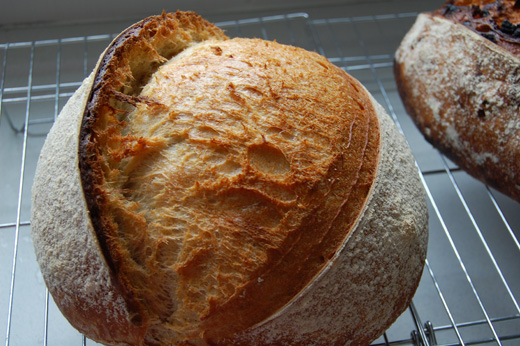

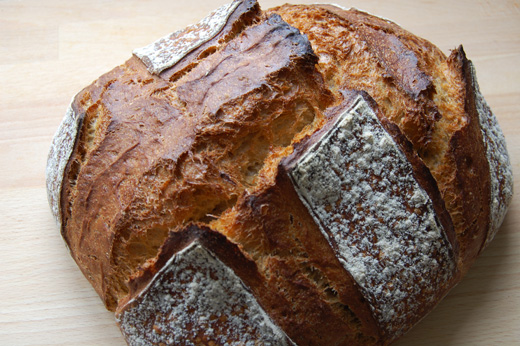



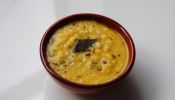


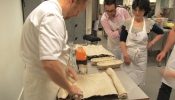














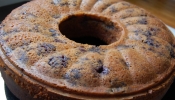


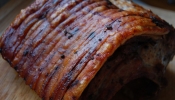

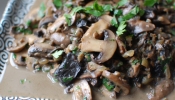

{ 8 comments… read them below or add one }
Firstly, I’d like to wish you and your family a Very Happy New Year and the same good wishes to everyone who posts on here.
2011 was an amazing learning year for you and I hope that this year will be an equally enjoyable one!
I thank you, in particular, for your Gran’s Portuguese way of cooking chicken!
Fabulous summary of your year of learning and sharing! x
Happy New Year Renée, wishing you a good healthy year ahead with your family.x
I have climbed a baking mountain Kavey!
You are amazing! Thank you and a Happy New Year! xx
Happy New Year Madhu!
Great stuff!! here’s to even more wonderful breads in your new baking space. It’s been a busy year in your kitchen and I’ve enjoyed reading your posts and seeing what you have been creating. xx Jo
Thanks Joanna, likewise.